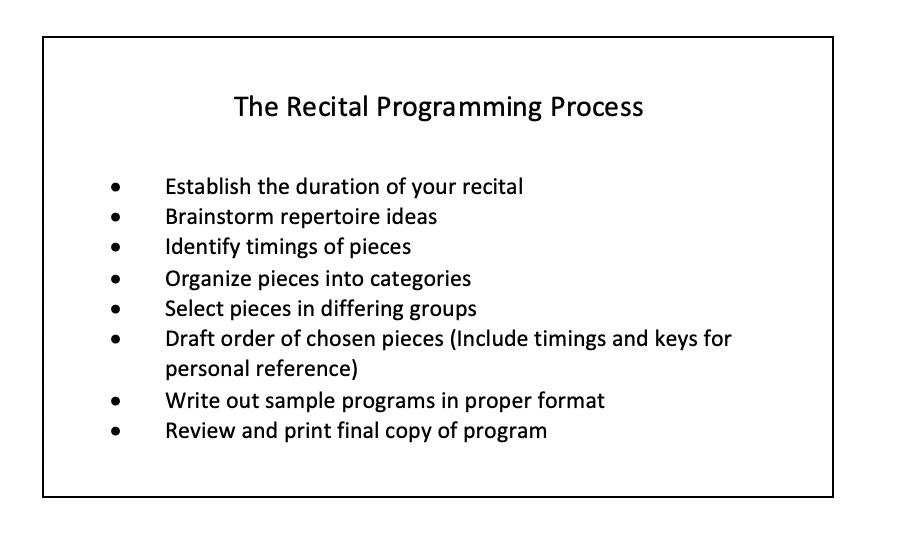Recitals are exciting opportunities to share with an audience music that is meaningful to you. Preparing for a recital should be a fun process that allows you to set new musical goals with a clear finish line, giving you the chance to immerse yourself in the repertoire. It is an event many of my students look forward to with anticipation. Each semester I talk with my students about their goals for the semester, choosing repertoire, and how to prepare for upcoming recitals and performances. It is helpful to receive feedback throughout the process, so I have included some helpful tips for programming your next recital.
It is your recital, so remember to select works that excite you. Preparing pieces you enjoy will keep you motivated to work on them for an extended period of time and ultimately inspire you to perform them well. First, establish the amount of time you have for your degree recital. Often times an undergraduate recital will range from 30 to 55 minutes, depending on the degree program. These expectations will vary among institutions, so talk with your professor about the criteria that will need to be met.
Begin by compiling a list of the music you are interested in playing and share them with your teacher. From there you can discuss these choices and make concrete decisions together. Take note of any interesting works you hear in student recitals, masterclasses, concerts, or on social media. Write down or circle them in the program and save them so that you can refer to them later. Look for works that will both challenge you and enhance your strengths; this will help you stay enthusiastic and also sustain your practice momentum. Notice which pieces you tend to gravitate towards and try to avoid the urge to play what is easiest and most familiar. It is important to be open to all music, for each recital is an opportunity to dive in to new and challenging repertoire and push your musical and technical abilities.
Once you have brainstormed pieces that interest you, narrow down your selection by choosing works that will add variety, complement each other, and create balance to your program. There are several elements to consider when crafting a balanced program. A well-proportioned recital contains works that encompass an assortment of musical periods. This provides an interesting selection of music for different groups of people and accentuates the idea that there is “something for everyone.” Include a diverse selection of solo, chamber, and flute and piano works which range from baroque to contemporary periods. Consider the length and movement structure of these works so that they complement each other, such as juxtaposing a multiple movement work with a shorter unaccompanied piece. This will offer musical interest and contrast for your audience.
To ensure that you are incorporating a variety of pieces on your recital, a sample chart has been included for your reference. The following table provides several musical categories that can be used as a guide to shape your program. When selecting your pieces, assign each one to an appropriate category. In most cases, a work will fall into multiple classifications. Once you understand which group your piece fits into, then you can substitute different works accordingly. This chart can help you recognize what style or type of piece your recital might be missing while also allowing for plenty of flexibility. If you find yourself interested in numerous pieces and struggling to make a decision, write down two or three different program options so that you can compare and pick which arrangement you like the best.
| Baroque Unaccompanied Chamber Ensemble French Contemporary Showy/Crowd Pleasers Sonata/Flute and Piano Multi-Movement with Piano |
Be aware of the duration of your pieces for this is an aspect that will also guide your selection process. Listen to different recordings and write down the time of each piece. Professional recordings tend to be faster so take into consideration the tempo that you can successfully perform the piece. Type out and properly format your program the way it will appear on paper. This allows you to see the flow, balance, and distribution between pieces. Include the times of each work for your personal reference; just remember to omit this information before printing the final program.
The duration of a recital typically ranges between 45 minutes to an hour and fifteen minutes. Anything beyond an hour and twenty minutes might be long for most audiences. When calculating the overall recital time, remember to allow extra time for re-setting, talking, walking on and off stage, and intermission. Depending on the length of your recital, an intermission is a nice option. This short break allows you to momentarily rest and re-focus before concluding your concert. It is appropriate and often appreciated by audiences to include an intermission if you have a longer program. Attempt to organize your program so that the first half is slightly longer than the second half. This will allow you to pace yourself, keep your energy level high, and maintain the audience’s interest to the very end.
Another important aspect of programming is to consider the key and mood of your chosen pieces. Different keys create distinctive moods, so it is important to be aware of this tendency and identify how they might complement or contrast each other. Try to avoid picking pieces in all major or minor keys. Programming all works that are slow and in minor keys can present a rather somber or heavy mood. Instead, bring variety to your repertoire by incorporating a mixture of fast and slow works in both major and minor keys. Also, notice how one piece ends and the next one begins. Many times, it is useful to play a portion of the end of one piece and the beginning of the next to hear how they transition into each other. It might be helpful to include the key of each piece when outlining your sample program so that you can avoid any similarities in key or mood. Just remember to omit this information on your final program copy.
Once you have observed several performances, you will begin to notice that recitals tend to have certain formulas for arranging pieces. Recognize the different shapes and structures of these programs. Some performances might contain substantial works on the first half and then save the fun showy pieces for the second half of the program. Other recitals might include a multi-movement work, flashy, or significant piece for the finale. Whatever program structure you choose, aim to conclude your recital program with a piece that you feel is impressive to audiences, showcases your strengths, and you are most excited about. There is no right or wrong way to program, but it is beneficial to be aware of what is most effective for the enjoyment of both you and the audience. Much of the process of programming can be reduced to observing the structure of other recitals, being aware of your audience, and trial and error.
Begin to work towards programming and performing several balanced recitals throughout your college career and musical development. Eventually you will understand the most effective way to arrange works that complement each other. After you have experience with this process you may want to explore the idea of creating a theme for your recital. To do this, look for pieces that are from different musical periods yet have one common thread. This could include themes such as the composers’ country of origin, dance themes, fantasies, or any other topic. Themed recitals can be extremely effective; however, it is important to first become comfortable with programming and performing several balanced recitals before moving on to a theme.
Timeline
Pacing your preparation and structuring a clear timeline leading up to the recital is an important part of the recital process. Give yourself plenty of time to prepare for your recital. Some pieces will require more preparation time than others, depending on the level of difficulty. In general, allow yourself at least four or more months to learn and fully understand these works. This will give you time not only to practice, but to listen to recordings, study the score, record yourself, work through musical ideas and technical challenges, and schedule critical rehearsal time with any collaborators. Plan to run your complete program all the way through a week and a half prior to your recital. The final week should be dedicated to slow practice and checking details and isolated spots rather than working out notes or rhythms. As you gain experience presenting recitals and practicing repertoire, you will eventually obtain an awareness and intuition of how much time you need to prepare a piece. It is far better to allow yourself more time than less.
Though you might view your degree recital as the ultimate performance goal, it is better to approach the event as being one of several performances. This mindset helps alleviate the pressure of a recital and reiterates the importance to perform as much as possible leading up to your performance. Schedule additional performances at venues a few weeks prior to your recital. Play in front of your peers, at retirement communities, or in other settings. This will give you a chance to play through your program for different audiences, allow you to ease some nerves, feel more comfortable on stage, and discover areas in the music that might need more practice and attention. Each performance that you give of this repertoire will only make it stronger and make you feel more confident.
Scheduling a dress rehearsal is another important part of your timeline. Depending on the availability of the performance space, it is appropriate to plan your dress rehearsal approximately a week before the recital. This will give you the opportunity to perform the program in the concert space. Play in the space as much as possible. Different venues and times of day can create unique and challenging performing conditions, which might lead to increased nerves, so it is important to have time to feel comfortable in the space around you. Have your teacher and friends listen to give feedback, check for balance, and observe staging. In addition to having listeners, it is extremely helpful to record yourself at the dress rehearsal. This is one of the most useful tools for instant feedback and will allow you to make immediate improvements on your playing.
Performing a recital should be an enjoyable opportunity to share music you love with a respective audience and celebrate your musical achievements and growth. Enjoy the experience and the repertoire that you have chosen to work on and share with your audience!
Here is a basic overview of the process and steps you can take to program your next recital.

Dr. Brielle Frost is Assistant Professor of Flute at Lamar University. She has performed and given masterclasses throughout the United States, Peru, Brazil, Italy, Costa Rica, and Canada. As an orchestral musician, she is a substitute player with the Symphony of Southeast Texas and has previously performed with the Valley Symphony Orchestra (TX) Steamboat Symphony Orchestra (CO), Topeka Symphony Orchestra (KS), Midland-Odessa Symphony Orchestra (TX) and the Colorado Dance Theatre Company (CO), as well as been a featured soloist with the Opus Chamber Ensemble (TX) and the Bailey Bach Festival (CO). In addition to orchestral playing, she is passionate about chamber music and is a founding member of the Ambrosia Flute Trio and the Pan American Trio and has performed and given masterclasses throughout Texas, Oklahoma, Colorado, Nevada, Louisiana, Florida, and Peru. Dr. Frost actively presents performances, clinics and lectures at conventions of the National Flute Association, Texas Music Educators Association, College Music Society Conference, the American Single Reed Summit, and the National Association of College Wind and Percussion Instructors. Prior to her appointment at Lamar University, Dr. Frost served on the faculty at the University of Texas-Rio Grande Valley and Western State Colorado University.

